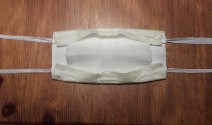Do-It-Yourself Mask - Additions
What do > Association Religious Clerical > Works of Apostolate

Do-It-Yourself Mask
an economic way to achieve it

ADDITIONS
Sewing mode of the Mask
The reference article also indicates the "sewing" mode, more precisely the sequence of holes that is observed to carry out the assembly of the mask.
In this regard, it is said that we proceed from point A1 to point F1 and from point A2 to point F2, acting on one half of the mask, and we proceed from point A3 to point F3 and from point A4 to point F4 on the other half of the mask.
In reality you can follow another sequence with similar results, precisely when you have passed the point C, instead of passing through the point D, you jump and pass through the point F and then go back passing through the point E, then exit from point D.
This operation must be done naturally on the two parts of the same half of the mask, it can also be done on the other two parts of the other half of the mask but not necessarily.
It follows that there are three possibilities for assembling the template: that indicated in the reference article; the one that provides for both halves of the mask the new succession method indicated in this article; one that involves the application of the two different sewing modes: one mode on one half of the mask and the other mode on the second half of the mask.
Everyone will be able to experiment with the most suitable methods for sewing the mask, bearing in mind that the mask can be worn in two different ways: according to a first modality but also according to a modality rotated 180 degrees with respect to the first modality.
.
.
Finishing the seam of the Mask
The choice of which sewing method to use, and which way to follow to wear it, also derives from the possibility of finishing once the stitching of the mask is finished, whatever the sewing mode of the template itself has been.
It is this: working on the outside of the mask, take the end of a string, fold it 90 degrees downwards and then proceed towards the inside of the mask where there is the portion of the string that comes out of the hole B. The garment that we have at it we pass it over the portion of string, we put it under it, and we immediately let it go outwards.
Of course, if we do this on one side of the mask, we must also do it on the other side; however, it is not necessary to do the same operation on the other half of the mask.
This operation, especially in some sewing cases, may prove appropriate because it guarantees greater adhesion of the mask to the face.
.
.

